A Critical Review on Artificial Intelligence—Based Microplastics Imaging Technology: Recent Advances, Hot-Spots and Challenges
Abstract
:1. Introduction
2. Methods
2.1. Data Acquisition and Whole Process
2.2. Assumptions and Conditions
2.2.1. Search Terms
2.2.2. Country Names
2.2.3. Database Time-Range
2.3. Science Mapping Analysis Tools
3. Fundamental Characteristics of AI-Based Microplastics Imaging Publications
3.1. Analysis of Literature Types
3.2. Number and Proportion of Published Papers per Year
3.3. Top 10 Research Areas
3.4. High Frequency Keywords and Density Mapping
4. State of AI Applications in Microplastics Imaging Research
4.1. Most Active Object Analysis and Collaborative Network Analysis
4.1.1. The Collaboration Network of Countries/Regions
4.1.2. The Most Contributing Affiliations
4.1.3. The Cooperation Networks of All Institutions
4.1.4. The Most Active Authors
4.1.5. The Closest Cooperation Network of Authors
4.1.6. Co-Occurrence Author Keywords
4.2. Citation and Co-Citation Structure Analysis
4.2.1. Citation Network Structure Analysis of Authors
4.2.2. Co-Citation Network Structure Analysis of Authors
4.2.3. Citation Network Structure Analysis of References
4.2.4. Co-Citation Network Structure Analysis of References
5. Research Hot-Spots and Development Trends
5.1. Knowledge Flow Analysis Based on Overlay Journals
5.2. Keywords Network and Their Temporal Evolution
5.3. Research Hot-Spots Analysis of Cluster View
6. Discussion
6.1. Gap between Deep CNNs Algorithm Application and MPs Imaging Technology
6.2. Data Open Access and Cooperation Mechanisms
6.3. Demand for Automatic Processing Innovation of the High-Volume Imagery
7. Conclusions and Perspectives
Author Contributions
Funding
Institutional Review Board Statement
Informed Consent Statement
Data Availability Statement
Acknowledgments
Conflicts of Interest
References
- Geyer, R.; Jambeck, J.R.; Law, K.L. Production, use, and fate of all plastics ever made. Sci. Adv. 2017, 3, e1700782. [Google Scholar] [CrossRef] [PubMed] [Green Version]
- Frias, J.P.G.L.; Nash, R. Microplastics: Finding a consensus on the definition. Mar. Pollut. Bull. 2019, 138, 145–147. [Google Scholar] [CrossRef] [PubMed]
- Stock, F.; Kochleus, C.; Bänsch-Baltruschat, B.; Brennholt, N.; Reifferscheid, G. Sampling techniques and preparation methods for microplastic analyses in the aquatic environment—A review. TrAC Trends Anal. Chem. 2019, 113, 84–92. [Google Scholar] [CrossRef]
- Thompson, R.C. Microplastics in the marine environment: Sources, consequences and solutions. In Marine Anthropogenic Litter; Springer: Cham, Switzerland, 2015. [Google Scholar] [CrossRef] [Green Version]
- Van Cauwenberghe, L.; Janssen, C.R. Microplastics in bivalves cultured for human consumption. Environ. Pollut. 2014, 193, 65–70. [Google Scholar] [CrossRef]
- Barboza, L.G.A.; Gimenez, B.C.G. Microplastics in the marine environment: Current trends and future perspectives. Mar. Pollut. Bull. 2015, 97, 5–12. [Google Scholar] [CrossRef]
- Dris, R.; Gasperi, J.; Mirande, C.; Mandin, C.; Guerrouache, M.; Langlois, V.; Tassin, B. A first overview of textile fibers, including microplastics, in indoor and outdoor environments. Environ. Pollut. 2017, 221, 453–458. [Google Scholar] [CrossRef] [Green Version]
- van Sebille, E.; Wilcox, C.; Lebreton, L.; Maximenko, N.; Hardesty, B.D.; van Franeker, J.A.; Eriksen, M.; Siegel, D.; Galgani, F.; Law, K.L. A global inventory of small floating plastic debris. Environ. Res. Lett. 2015, 10, 124006. [Google Scholar] [CrossRef]
- Karlsson, T.M.; Vethaak, A.D.; Almroth, B.C.; Ariese, F.; van Velzen, M.; Hassellöv, M.; Leslie, H.A. Screening for microplastics in sediment, water, marine invertebrates and fish: Method development and microplastic accumulation. Mar. Pollut. Bull. 2017, 122, 403–408. [Google Scholar] [CrossRef]
- Bläsing, M.; Amelung, W. Plastics in soil: Analytical methods and possible sources. Sci. Total Environ. 2018, 612, 422–435. [Google Scholar] [CrossRef]
- Martin, C.; Parkes, S.; Zhang, Q.; Zhang, X.; McCabe, M.F.; Duarte, C.M. Use of unmanned aerial vehicles for efficient beach litter monitoring. Mar. Pollut. Bull. 2018, 131, 662–673. [Google Scholar] [CrossRef] [Green Version]
- Bhardwaj, A.; Sam, L.; Akanksha; Martín-Torres, F.J.; Kumar, R. UAVs as remote sensing platform in glaciology: Present applications and future prospects. Remote Sens. Environ. 2016, 175, 196–204. [Google Scholar] [CrossRef]
- Turner, I.L.; Harley, M.D.; Drummond, C.D. UAVs for coastal surveying. Coast. Eng. 2016, 114, 19–24. [Google Scholar] [CrossRef]
- Arise, M.; Kurazume, R. Development of Garbage Collecting Robot for Marine Microplastics: Detection of Microplastics using Laser Reflectance. Proc. JSME Annu. Conf. Robot. Mechatron. (Robomec) 2021, 2021, 1P2-G09. [Google Scholar] [CrossRef]
- Chen, Y.; Lin, Z.; Zhao, X.; Wang, G.; Gu, Y. Deep Learning-Based Classification of Hyperspectral Data. IEEE J. Sel. Top. Appl. Earth Obs. Remote Sens. 2014, 7, 2094–2107. [Google Scholar] [CrossRef]
- Tian, C.; Fei, L.; Zheng, W.; Xu, Y.; Zuo, W.; Lin, C.-W. Deep learning on image denoising: An overview. Neural Netw. 2020, 131, 251–275. [Google Scholar] [CrossRef] [PubMed]
- Gonzalez, L.F.; Montes, G.A.; Puig, E.; Johnson, S.; Mengersen, K.; Gaston, K.J. Unmanned Aerial Vehicles (UAVs) and Artificial Intelligence Revolutionizing Wildlife Monitoring and Conservation. Sensors 2016, 16, 97. [Google Scholar] [CrossRef] [Green Version]
- Hodgson, J.C.; Baylis, S.M.; Mott, R.; Herrod, A.; Clarke, R.H. Precision wildlife monitoring using unmanned aerial vehicles. Sci. Rep. 2016, 6, 22574. [Google Scholar] [CrossRef] [Green Version]
- Zettler, E.R.; Mincer, T.J.; Amaral-Zettler, L.A. Life in the “Plastisphere”: Microbial Communities on Plastic Marine Debris. Environ. Sci. Technol. 2013, 47, 7137–7146. [Google Scholar] [CrossRef]
- Amaral-Zettler, L.A.; Zettler, E.R.; Mincer, T.J. Ecology of the plastisphere. Nat. Rev. Microbiol. 2020, 18, 139–151. [Google Scholar] [CrossRef] [PubMed]
- Badrinarayanan, V.; Kendall, A.; Cipolla, R. SegNet: A Deep Convolutional Encoder-Decoder Architecture for Image Segmentation. IEEE Trans. Pattern Anal. Mach. Intell. 2017, 39, 2481–2495. [Google Scholar] [CrossRef]
- Digka, N.; Tsangaris, C.; Kaberi, H.; Adamopoulou, A.; Zeri, C. Microplastic Abundance and Polymer Types in a Mediterranean Environment. In Proceedings of the International Conference on Microplastic Pollution in the Mediterranean Sea; Springer: Cham, Switzerland, 2018; pp. 17–24. [Google Scholar]
- He, K.; Zhang, X.; Ren, S.; Sun, J. Deep Residual Learning for Image Recognition. In Proceedings of the 2016 IEEE Conference on Computer Vision and Pattern Recognition (CVPR), Las Vegas, NV, USA, 27–30 June 2016; pp. 770–778. [Google Scholar]
- Navarro, J.L.; Castrillón-Santana, M.; Sánchez-Nielsen, E.; Zarco, B.; Herrera, A.; Martínez, I.; Gómez, M. Deep learning approach for automatic microplastics counting and classification. Sci. Total Environ. 2021, 765, 142728. [Google Scholar] [CrossRef] [PubMed]
- Simonyan, K.; Zisserman, A.J.C. Very Deep Convolutional Networks for Large-Scale Image Recognition. arXiv 2015, arXiv:1409.1556. [Google Scholar] [CrossRef]
- Xing, F.; Xie, Y.; Su, H.; Liu, F.; Yang, L. Deep Learning in Microscopy Image Analysis: A Survey. IEEE Trans. Neural Netw. Learn. Syst. 2018, 29, 4550–4568. [Google Scholar] [CrossRef]
- Wang, H.; Xu, Z.; Zeng, X.-J. Modeling complex linguistic expressions in qualitative decision making_clean. Knowl.-Based Syst. 2018, 144, 174–187. [Google Scholar] [CrossRef] [Green Version]
- Borgman, C.L.J.C.R. Bibliometrics and Scholarly Communication. Commun. Res. 1989, 16, 583–599. [Google Scholar] [CrossRef]
- Chen, C. CiteSpace II: Detecting and visualizing emerging trends and transient patterns in scientific literature. J. Am. Soc. Inf. Sci. Technol. 2006, 57, 359–377. [Google Scholar] [CrossRef] [Green Version]
- Stopar, K.; Bartol, T. Digital competences, computer skills and information literacy in secondary education: Mapping and visualization of trends and concepts. Scientometrics 2018, 118, 479–498. [Google Scholar] [CrossRef]
- van Eck, N.J.; Waltman, L. Software survey: VOSviewer, a computer program for bibliometric mapping. Scientometrics 2010, 84, 523–538. [Google Scholar] [CrossRef] [Green Version]
- Miau, S.; Yang, J.-M. Bibliometrics-based evaluation of the Blockchain research trend: 2008—March 2017. Technol. Anal. Strateg. Manag. 2018, 30, 1–17. [Google Scholar] [CrossRef]
- Liu, W. A Bibliometric Analysis of Fuzzy Decision Research During 1970–2015. Int. J. Fuzzy Syst. 2016, 19, 1–14. [Google Scholar] [CrossRef]
- Li, Y.; Xu, Z.; Wang, X.; Wang, X. A bibliometric analysis on deep learning during 2007–2019. Int. J. Mach. Learn. Cybern. 2020, 11, 2807–2826. [Google Scholar] [CrossRef]
- Nasir, A.; Shaukat, K.; Hameed, I.A.; Luo, S.; Alam, T.M.; Iqbal, F. A Bibliometric Analysis of Corona Pandemic in Social Sciences: A Review of Influential Aspects and Conceptual Structure. IEEE Access 2020, 8, 133377–133402. [Google Scholar] [CrossRef] [PubMed]
- Merigo, J.M.; Rocafort, A.; Aznar-Alarcón, J. Bibliometric Overview of Business & Economics Research. J. Bus. Econ. Manag. 2016, 17, 397–413. [Google Scholar] [CrossRef] [Green Version]
- Laengle, S.; Merigó, J.M.; Miranda, J.; Słowiński, R.; Bomze, I.; Borgonovo, E.; Dyson, R.G.; Oliveira, J.F.; Teunter, R. Forty years of the European Journal of Operational Research: A bibliometric overview. Eur. J. Oper. Res. 2017, 262, 803–816. [Google Scholar] [CrossRef] [Green Version]
- Yu, D.; Xu, Z.; Pedrycz, W.; Wang, W. Information sciences 1968–2016: A retrospective analysis with text mining and bibliometric. Inf. Sci. 2017, 418–419, 619–634. [Google Scholar] [CrossRef]
- Niţă, A. Empowering impact assessments knowledge and international research collaboration—A bibliometric analysis of Environmental Impact Assessment Review journal. Environ. Impact Assess. Rev. 2019, 78, 106283. [Google Scholar] [CrossRef]
- Cobo, M.; López-Herrera, A.G.; Herrera-Viedma, E.; Herrera, F. Science Mapping Software Tools: Review, Analysis, and Cooperative Study Among Tools. J. Am. Soc. Inf. Sci. Technol. 2011, 62, 1382–1402. [Google Scholar] [CrossRef]
- Mourao, P.; Martinho, V. Choosing the best socioeconomic nutrients for the best trees: A discussion about the distribution of Portuguese Trees of Public Interest. Environ. Dev. Sustain. 2021, 23, 5985–6001. [Google Scholar] [CrossRef]
- Kou, G.; Peng, Y.; Wang, G. Evaluation of clustering algorithms for financial risk analysis using MCDM methods. Inf. Sci. 2014, 275, 1–12. [Google Scholar] [CrossRef]
- Choi, J.; Yi, S.; Lee, K. Analysis of keyword networks in MIS research and implications for predicting knowledge evolution. Inf. Manag. 2011, 48, 371–381. [Google Scholar] [CrossRef]
- Padilla, F.; Gallardo, M.; Manzano-Agugliaro, F. Global trends in nitrate leaching research in the 1960–2017 period. Sci. Total Environ. 2018, 643, 400–413. [Google Scholar] [CrossRef] [PubMed]
- Bianco, V.; Memmolo, P.; Carcagnì, P.; Merola, F.; Paturzo, M.; Distante, C.; Ferraro, P. Microplastic Identification via Holographic Imaging and Machine Learning. Adv. Intell. Syst. 2020, 2, 1900153. [Google Scholar] [CrossRef] [Green Version]
- Kedzierski, M.; Falcou-Préfol, M.; Kerros, M.E.; Henry, M.; Pedrotti, M.L.; Bruzaud, S. A machine learning algorithm for high throughput identification of FTIR spectra: Application on microplastics collected in the Mediterranean Sea. Chemosphere 2019, 234, 242–251. [Google Scholar] [CrossRef]
- Lorenzo-Navarro, J.; Castrillón Santana, M.; Gómez, M.; Herrera, A.; Marín-Reyes, P. Automatic Counting and Classification of Microplastic Particles. In Proceedings of the 7th International Conference on Pattern Recognition Applications and Methods—ICPRAM, Funchal, Portugal, 16–18 January 2018; pp. 646–652. [Google Scholar]
- Primpke, S.A.; Dias, P.; Gerdts, G. Automated identification and quantification of microfibres and microplastics. Anal. Methods 2019, 11, 2138–2147. [Google Scholar] [CrossRef]
- Hidalgo-Ruz, V.; Gutow, L.; Thompson, R.; Thiel, M. Microplastics in the Marine Environment: A Review of the Methods Used for Identification and Quantification. Environ. Sci. Technol. 2012, 46, 3060–3075. [Google Scholar] [CrossRef] [PubMed]
- Jambeck, J.; Geyer, R.; Wilcox, C.; Siegler, T.; Perryman, M.; Andrady, A.; Narayan, R.; Law, K. Marine pollution. Plastic waste inputs from land into the ocean. Science 2015, 347, 768–771. [Google Scholar] [CrossRef] [PubMed]
- Qiu, Z.; Zhao, S.; Feng, X.; He, Y. Transfer learning method for plastic pollution evaluation in soil using NIR sensor. Sci. Total Environ. 2020, 740, 140118. [Google Scholar] [CrossRef]
- Brandt, J.; Mattsson, K.; Hassellöv, M. Deep Learning for Reconstructing Low-Quality FTIR and Raman Spectra─A Case Study in Microplastic Analyses. Anal. Chem. 2021, 93, 16360–16368. [Google Scholar] [CrossRef]
- Chen, X.; Zhou, J.; Yuan, L.M.; Huang, G.; Chen, X.; Shi, W. Spectroscopic Identification of Environmental Microplastics. IEEE Access 2021, 9, 47615–47620. [Google Scholar] [CrossRef]
- Meyers, N.; Catarino, A.I.; Declercq, A.M.; Brenan, A.; Devriese, L.; Vandegehuchte, M.; De Witte, B.; Janssen, C.; Everaert, G. Microplastic detection and identification by Nile red staining: Towards a semi-automated, cost- and time-effective technique. Sci. Total Environ. 2022, 823, 153441. [Google Scholar] [CrossRef]
- Guo, Y.; Ma, W.; Li, J.; Liu, W.; Qi, P.; Ye, Y.; Guo, B.; Zhang, J.; Qu, C. Effects of microplastics on growth, phenanthrene stress, and lipid accumulation in a diatom, Phaeodactylum tricornutum. Environ. Pollut. 2020, 257, 113628. [Google Scholar] [CrossRef] [PubMed]
- Jun-Ichiro, W.; Yang, S.; Naoto, M. Underwater and airborne monitoring of marine ecosystems and debris. J. Appl. Remote Sens. 2019, 13, 1–10. [Google Scholar] [CrossRef]
- Takaya, K.; Shibata, A.; Mizuno, Y.; Ise, T. Unmanned aerial vehicles and deep learning for assessment of anthropogenic marine debris on beaches on an island in a semi-enclosed sea in Japan. Environ. Res. Commun. 2022, 4, 015003. [Google Scholar] [CrossRef]
- Li, C.; Wang, L.; Ji, S.; Chang, M.; Wang, L.; Gan, Y.; Liu, J. The ecology of the plastisphere: Microbial composition, function, assembly, and network in the freshwater and seawater ecosystems. Water Res. 2021, 202, 117428. [Google Scholar] [CrossRef]
- Jeong, J.; Choi, J. Development of AOP relevant to microplastics based on toxicity mechanisms of chemical additives using ToxCast™ and deep learning models combined approach. Environ. Int. 2020, 137, 105557. [Google Scholar] [CrossRef]
- Sarkar, D.J.; Das Sarkar, S.; Das, B.K.; Sahoo, B.K.; Das, A.; Nag, S.K.; Manna, R.K.; Behera, B.K.; Samanta, S. Occurrence, fate and removal of microplastics as heavy metal vector in natural wastewater treatment wetland system. Water Res. 2021, 192, 116853. [Google Scholar] [CrossRef]
- Zhang, J.; Yu, F.; Hu, X.; Gao, Y.; Qu, Q. Multifeature superposition analysis of the effects of microplastics on microbial communities in realistic environments. Environ. Int. 2022, 162, 107172. [Google Scholar] [CrossRef]
- Suzuki, S.; Sawada, T.; Serizawa, T. Identification of Water-Soluble Polymers through Discrimination of Multiple Optical Signals from a Single Peptide Sensor. ACS Appl. Mater. Interfaces 2021, 13, 55978–55987. [Google Scholar] [CrossRef]
- Valentino, M.; Bĕhal, J.; Bianco, V.; Itri, S.; Mossotti, R.; Fontana, G.D.; Battistini, T.; Stella, E.; Miccio, L.; Ferraro, P. Intelligent polarization-sensitive holographic flow-cytometer: Towards specificity in classifying natural and microplastic fibers. Sci. Total Environ. 2022, 815, 152708. [Google Scholar] [CrossRef]
- Yurtsever, M.; Yurtsever, U. Use of a convolutional neural network for the classification of microbeads in urban wastewater. Chemosphere 2019, 216, 271–280. [Google Scholar] [CrossRef]
- Fallati, L.; Polidori, A.; Salvatore, C.; Saponari, L.; Savini, A.; Galli, P. Anthropogenic Marine Debris assessment with Unmanned Aerial Vehicle imagery and deep learning: A case study along the beaches of the Republic of Maldives. Sci. Total Environ. 2019, 693, 133581. [Google Scholar] [CrossRef] [PubMed]
- Shi, B.; Patel, M.; Yu, D.; Yan, J.; Li, Z.; Petriw, D.; Pruyn, T.; Smyth, K.; Passeport, E.; Miller, R.J.D.; et al. Automatic quantification and classification of microplastics in scanning electron micrographs via deep learning. Sci. Total Environ. 2022, 825, 153903. [Google Scholar] [CrossRef] [PubMed]
- Vidal, C.; Pasquini, C. A comprehensive and fast microplastics identification based on near-infrared hyperspectral imaging (HSI-NIR) and chemometrics. Environ. Pollut. 2021, 285, 117251. [Google Scholar] [CrossRef] [PubMed]
- Lee, K.S.; Chen, H.L.; Ng, Y.S.; Maul, T.; Gibbins, C.; Ting, K.-N.; Amer, M.; Camara, M. U-Net skip-connection architectures for the automated counting of microplastics. Neural Comput. Appl. 2022, 34, 7283–7297. [Google Scholar] [CrossRef]
- Tan, S.; Taylor, J.A.; Passeport, E. Efficient Prediction of Microplastic Counts from Mass Measurements. ACS ES&T Water 2022, 2, 299–308. [Google Scholar] [CrossRef]
- Michel, A.P.M.; Morrison, A.E.; Preston, V.L.; Marx, C.T.; Colson, B.C.; White, H.K. Rapid Identification of Marine Plastic Debris via Spectroscopic Techniques and Machine Learning Classifiers. Environ. Sci. Technol. 2020, 54, 10630–10637. [Google Scholar] [CrossRef]
- Bianco, V.; Pirone, D.; Memmolo, P.; Merola, F.; Ferraro, P. Identification of Microplastics Based on the Fractal Properties of Their Holographic Fingerprint. ACS Photonics 2021, 8, 2148–2157. [Google Scholar] [CrossRef]
- Grant-Jacob, J.A.; Xie, Y.; Mackay, B.S.; Praeger, M.; McDonnell, M.D.T.; Heath, D.J.; Loxham, M.; Eason, R.W.; Mills, B. Particle and salinity sensing for the marine environment via deep learning using a Raspberry Pi. Environ. Res. Commun. 2019, 1, 035001. [Google Scholar] [CrossRef]
- Kaandorp, M.L.A.; Ypma, S.L.; Boonstra, M.; Dijkstra, H.A.; van Sebille, E. Using machine learning and beach cleanup data to explain litter quantities along the Dutch North Sea coast. Ocean Sci. 2022, 18, 269–293. [Google Scholar] [CrossRef]
- Ferdous, M.; Ahsan, S.M.M. A Computer Vision-based System for Surgical Waste Detection. Int. J. Adv. Comput. Sci. Appl. 2022, 13, 554. [Google Scholar] [CrossRef]
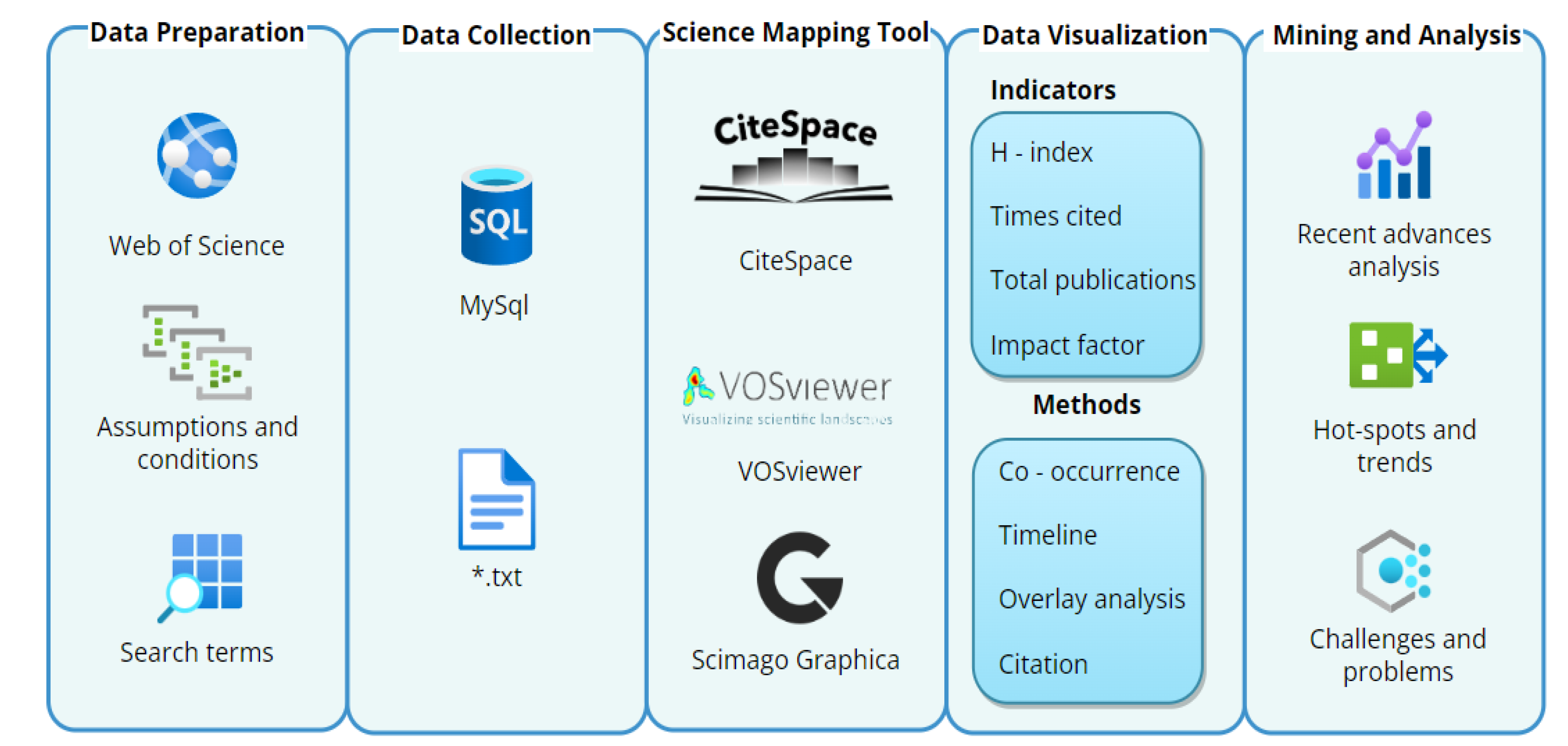
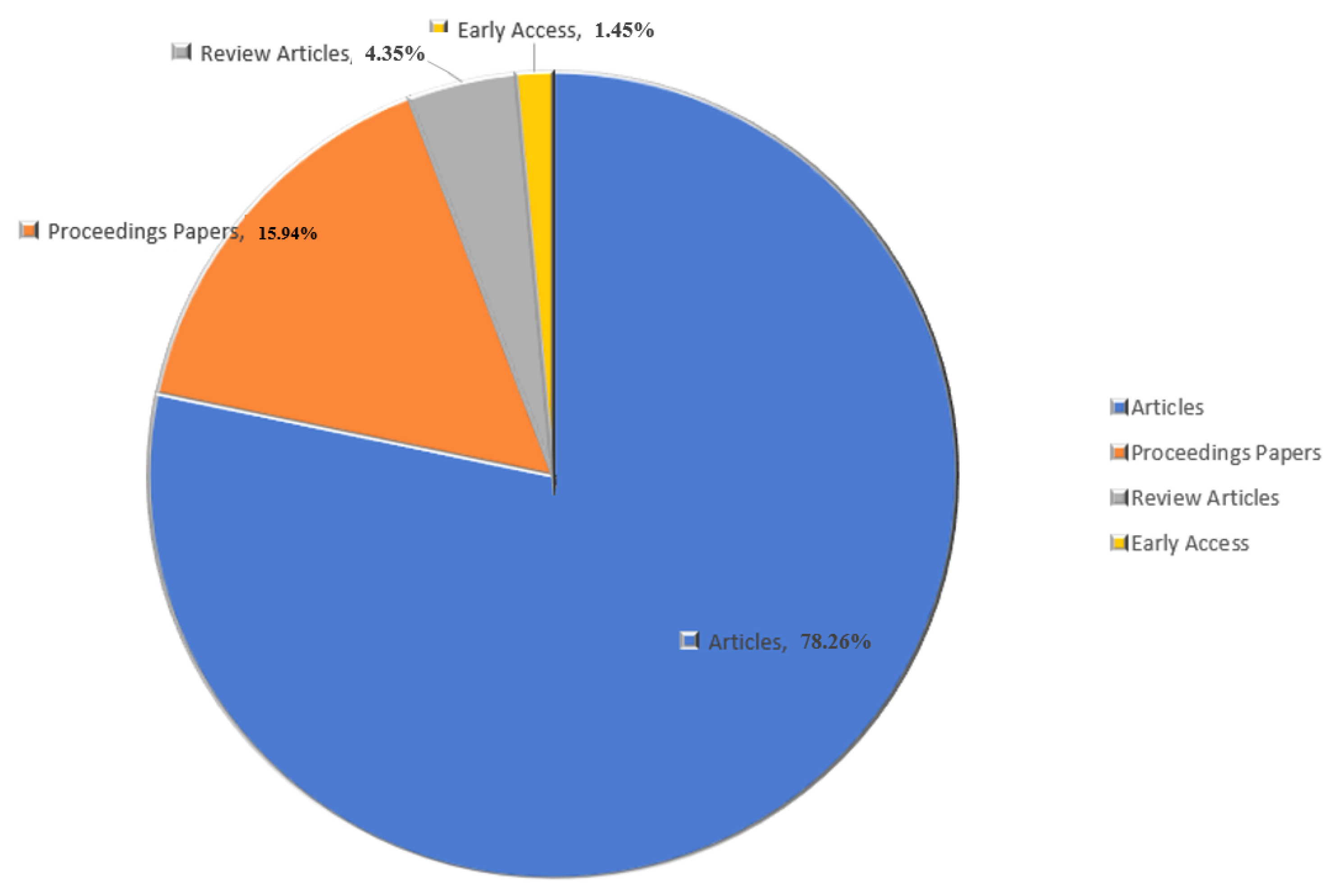

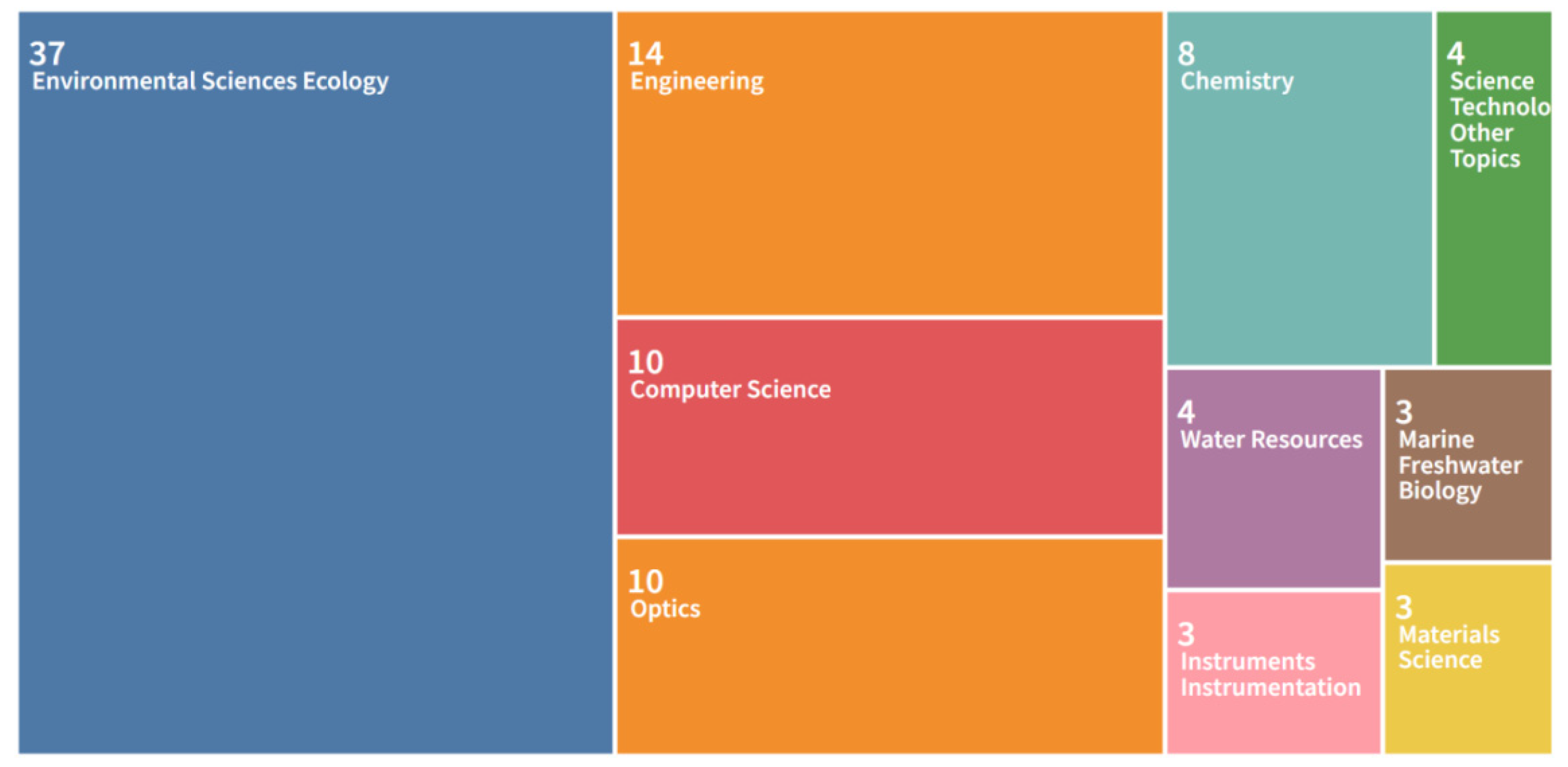
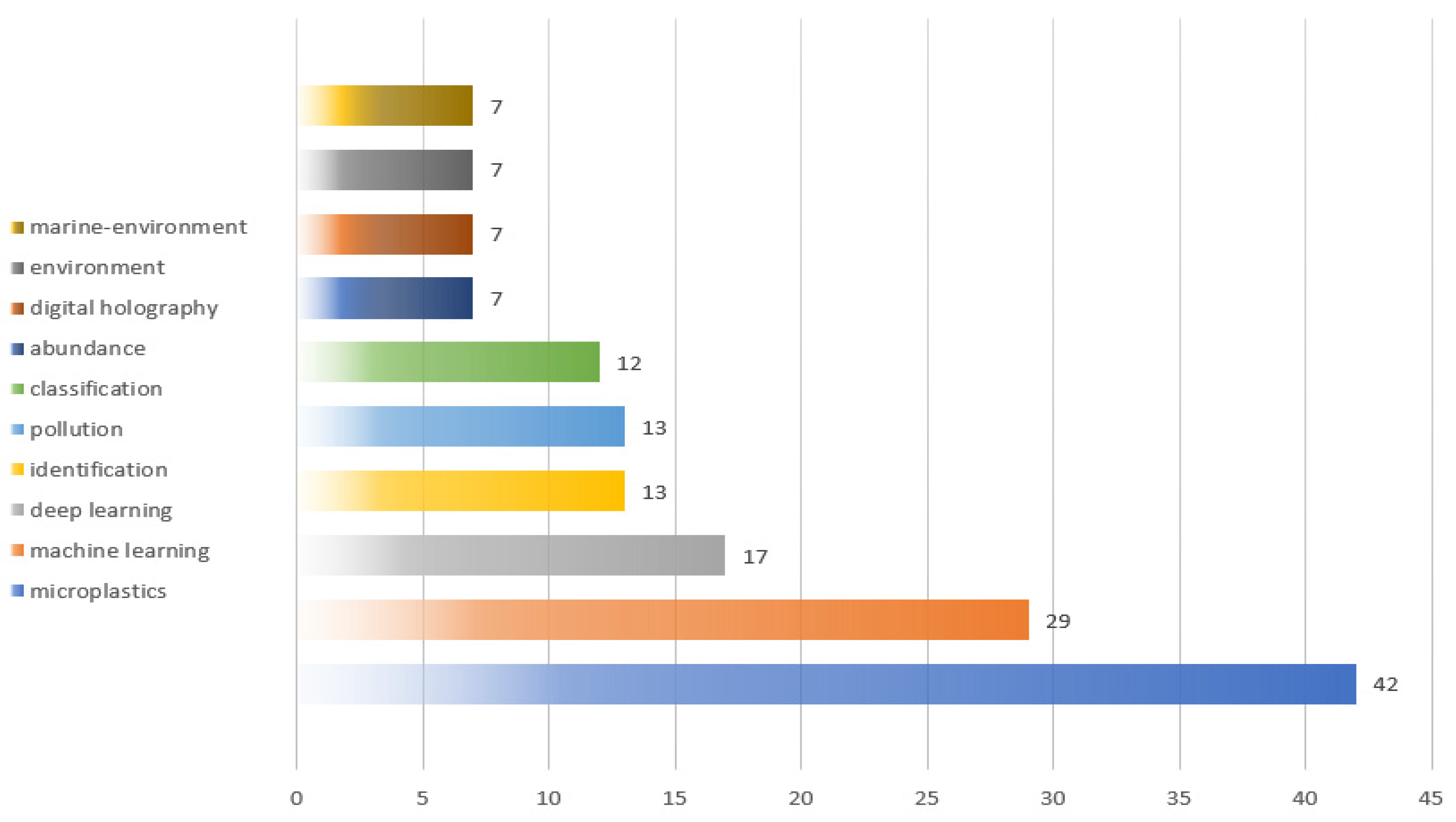

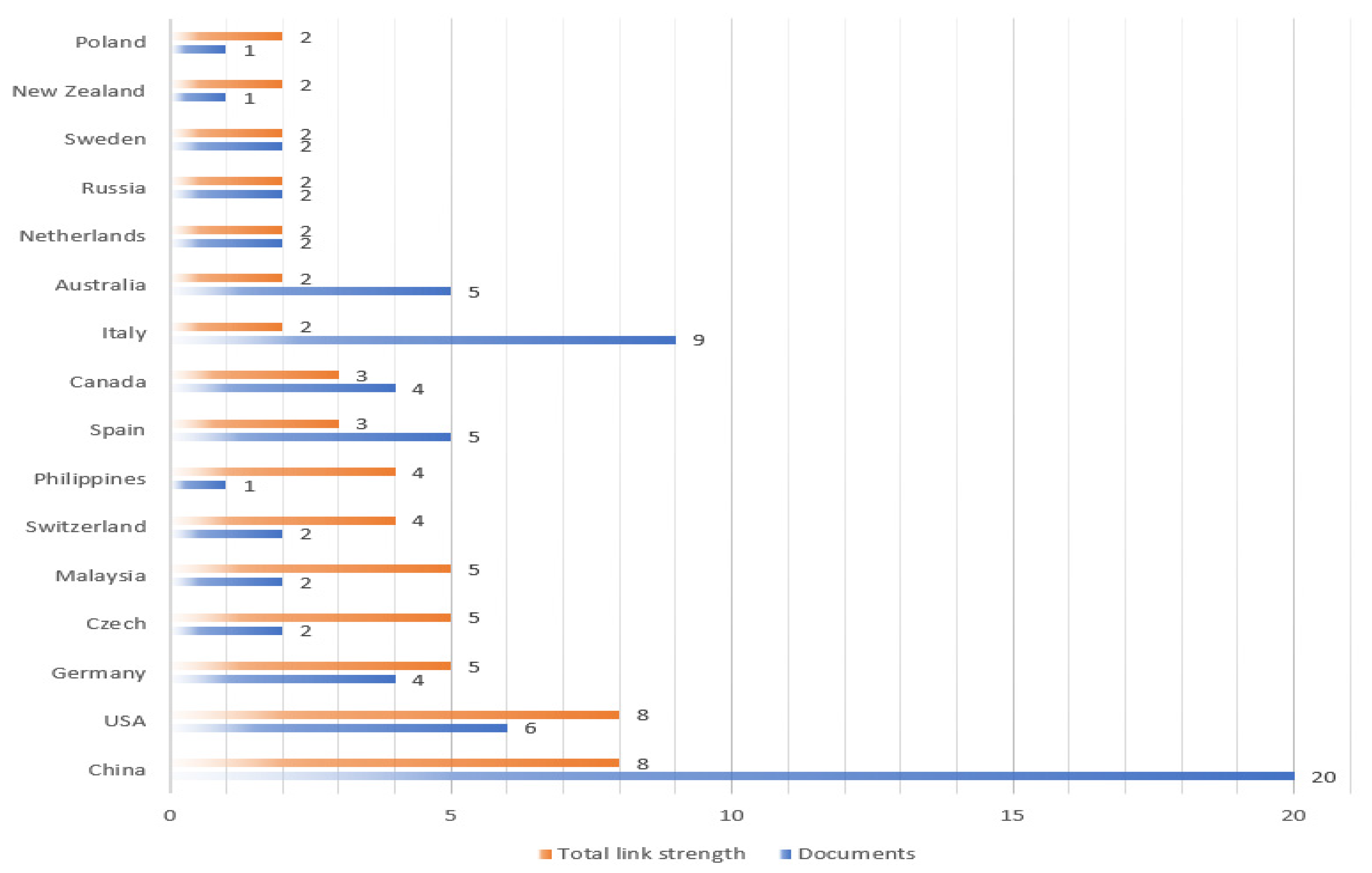
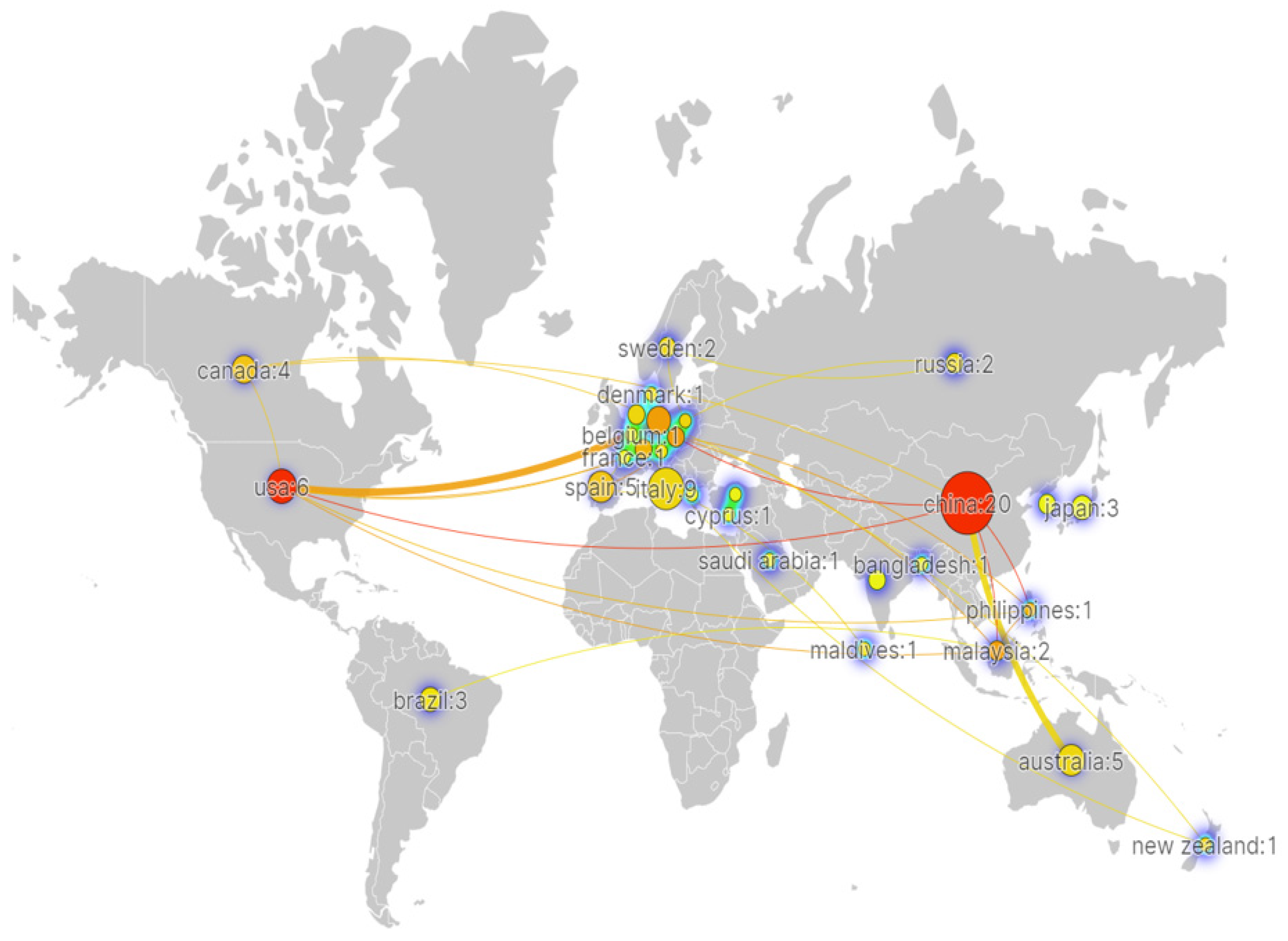
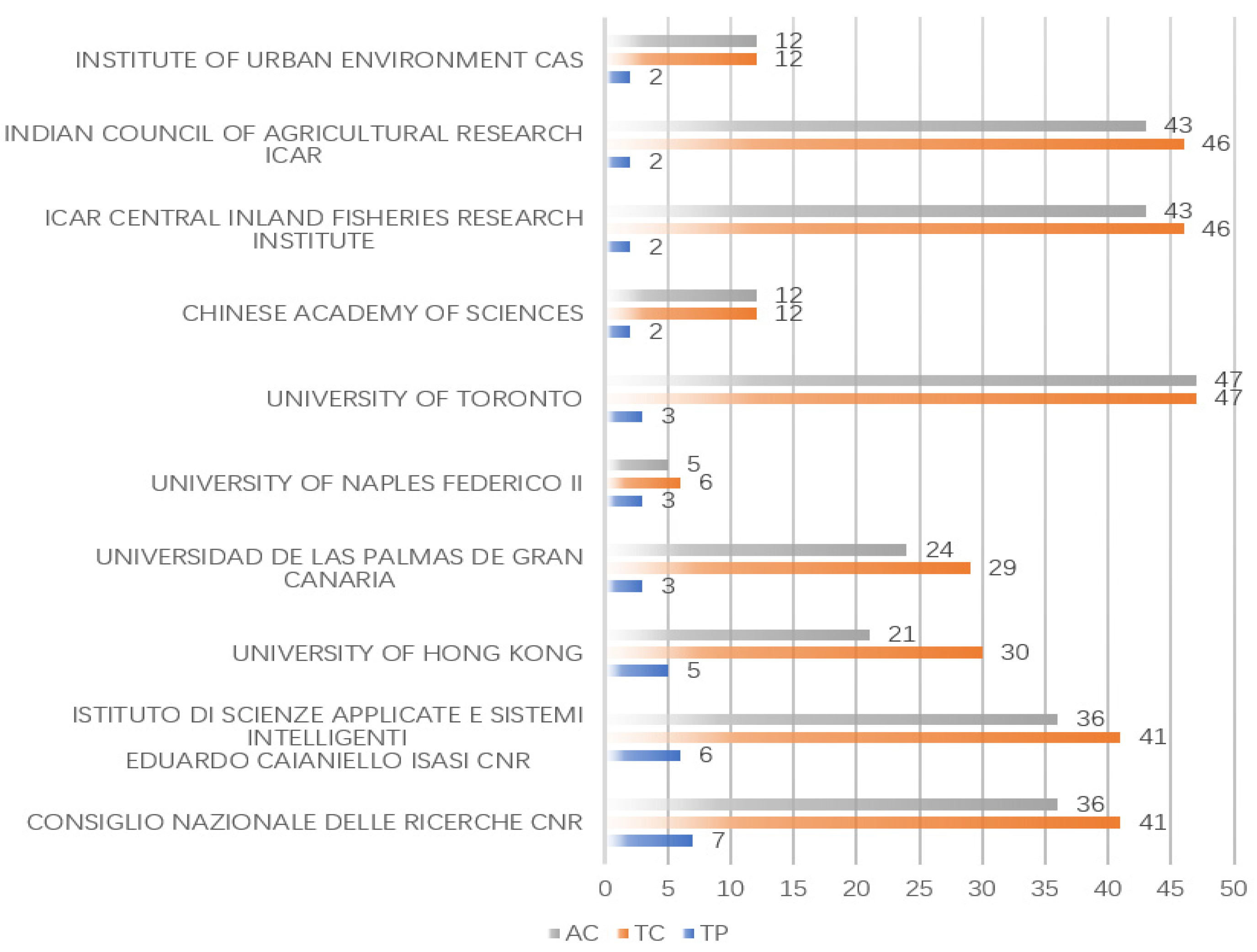
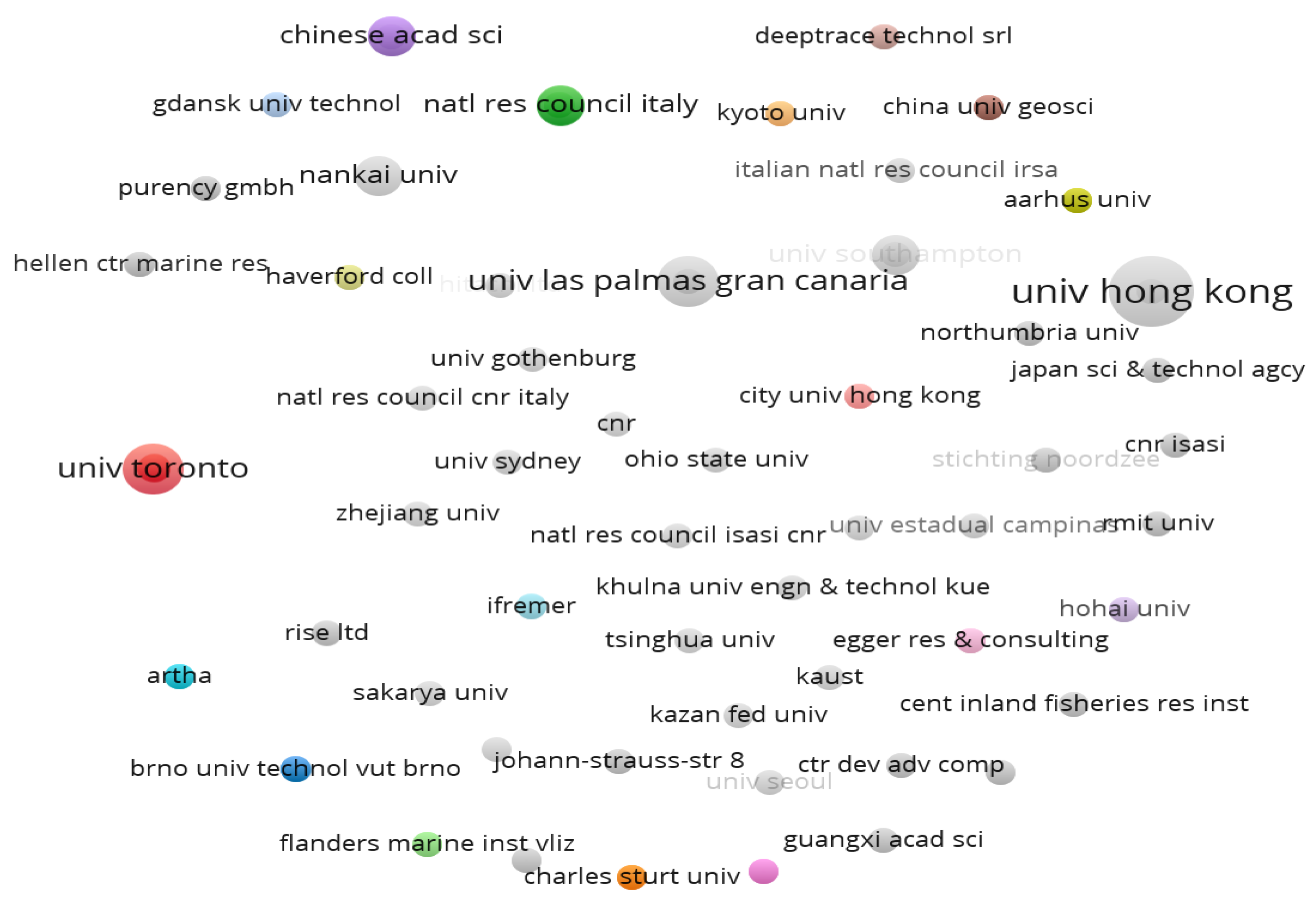
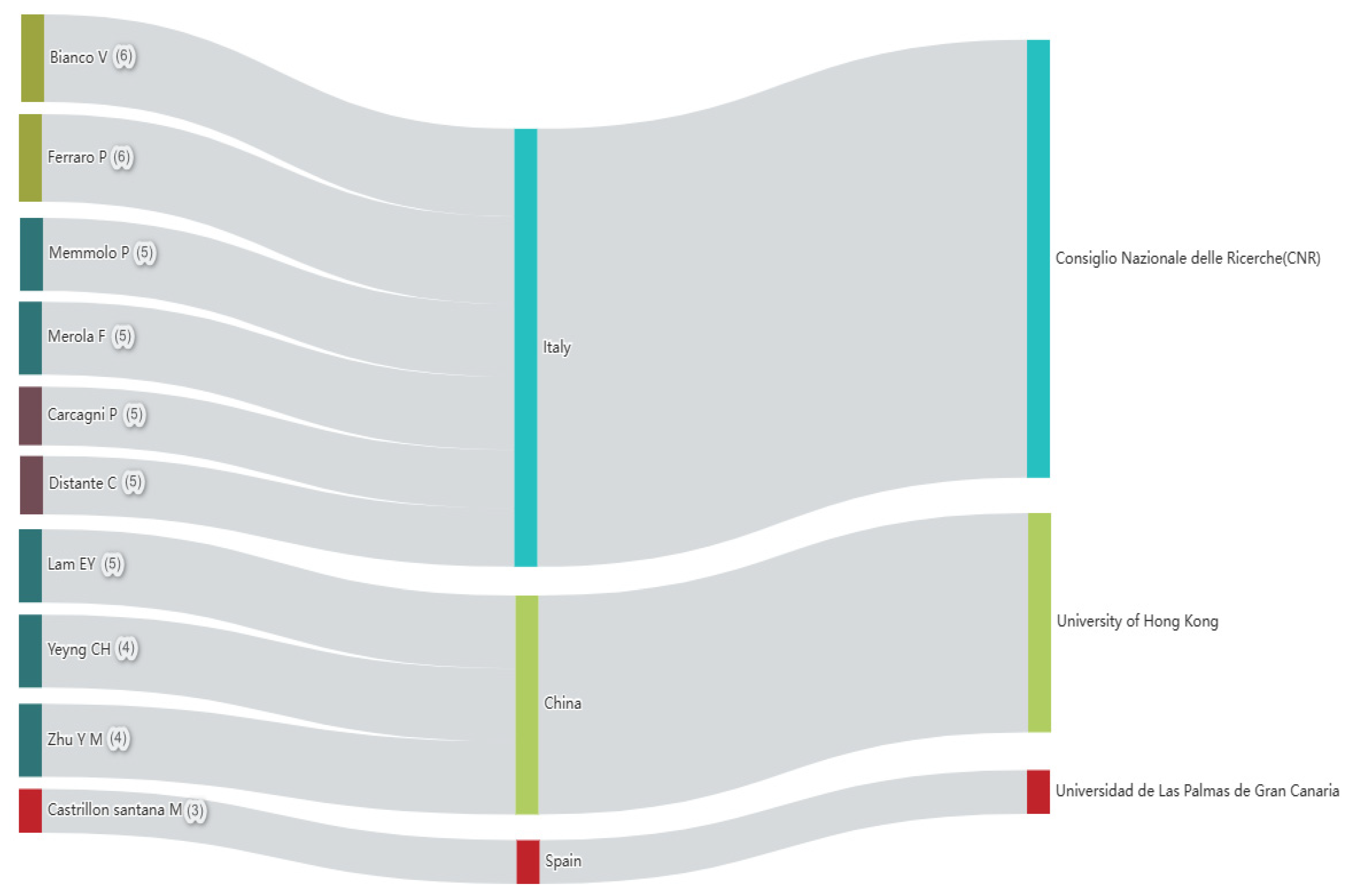
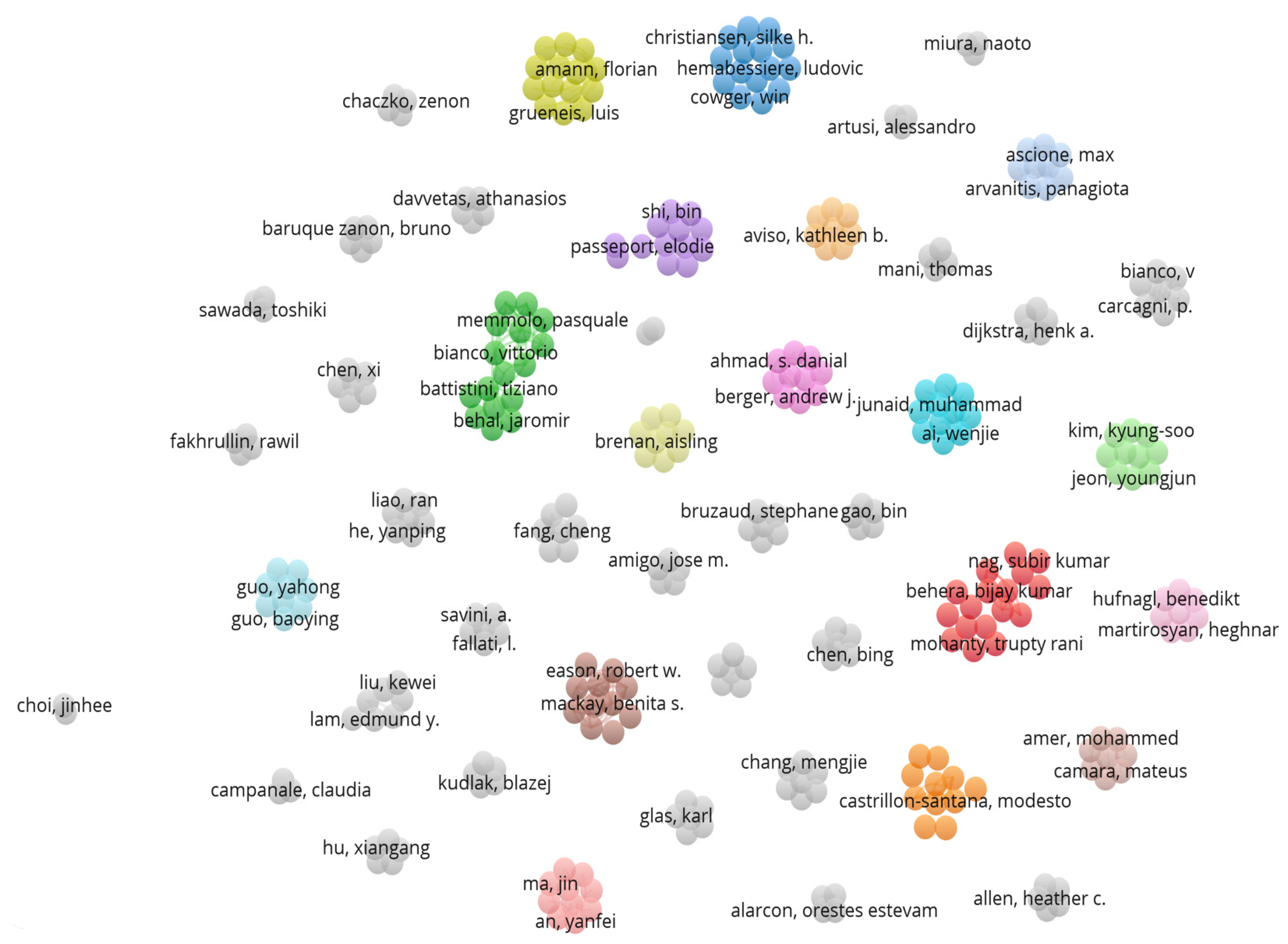
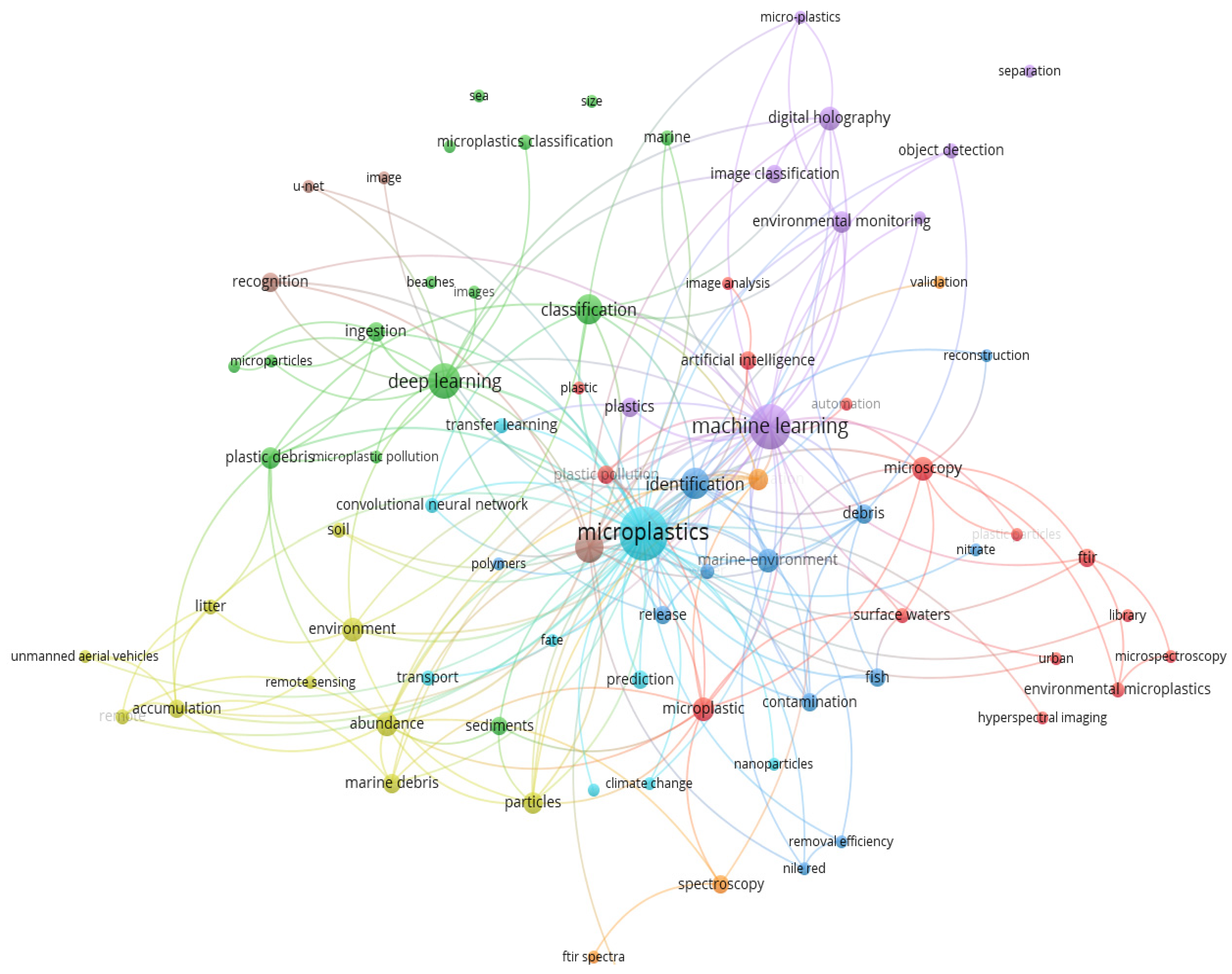
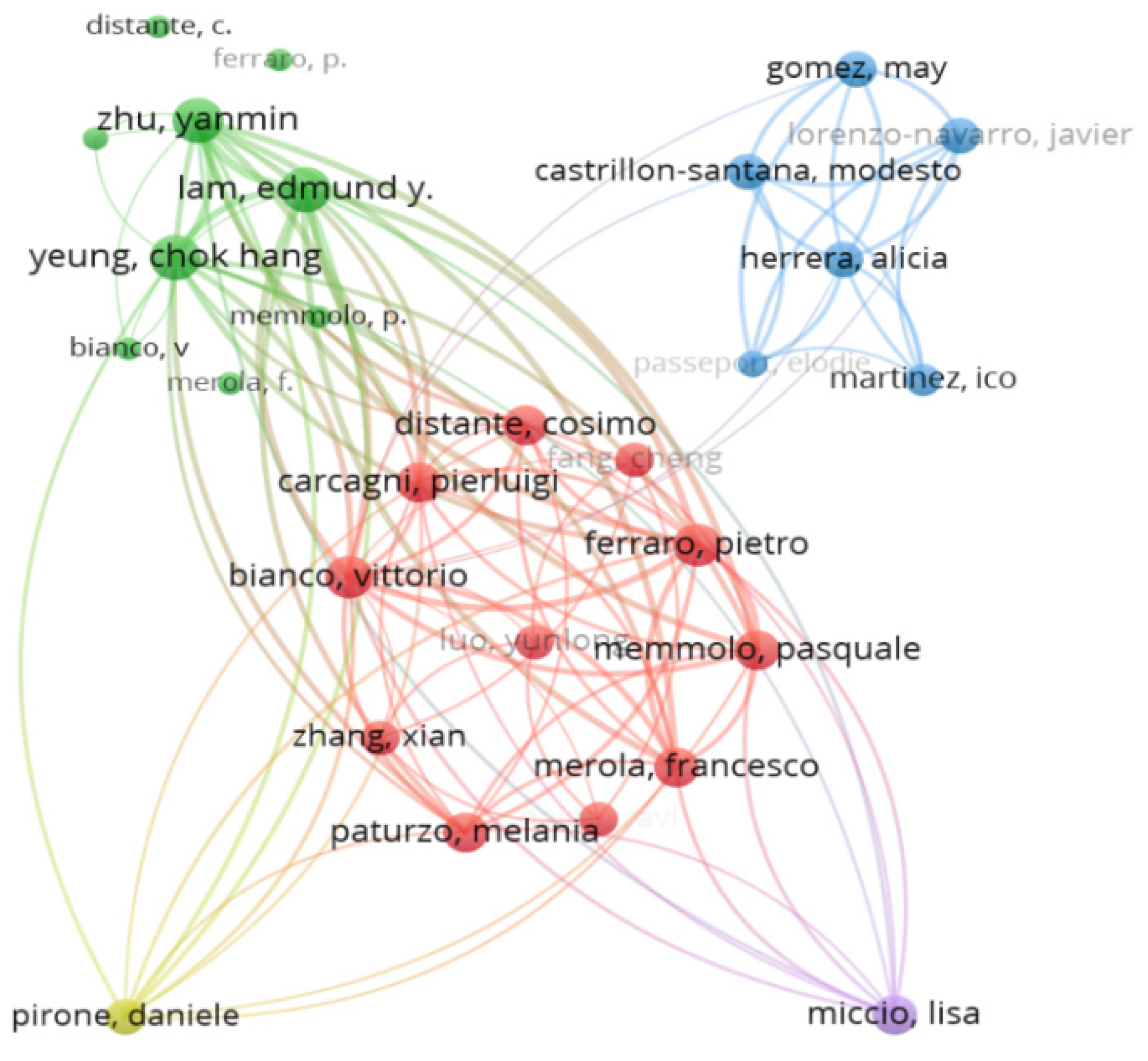
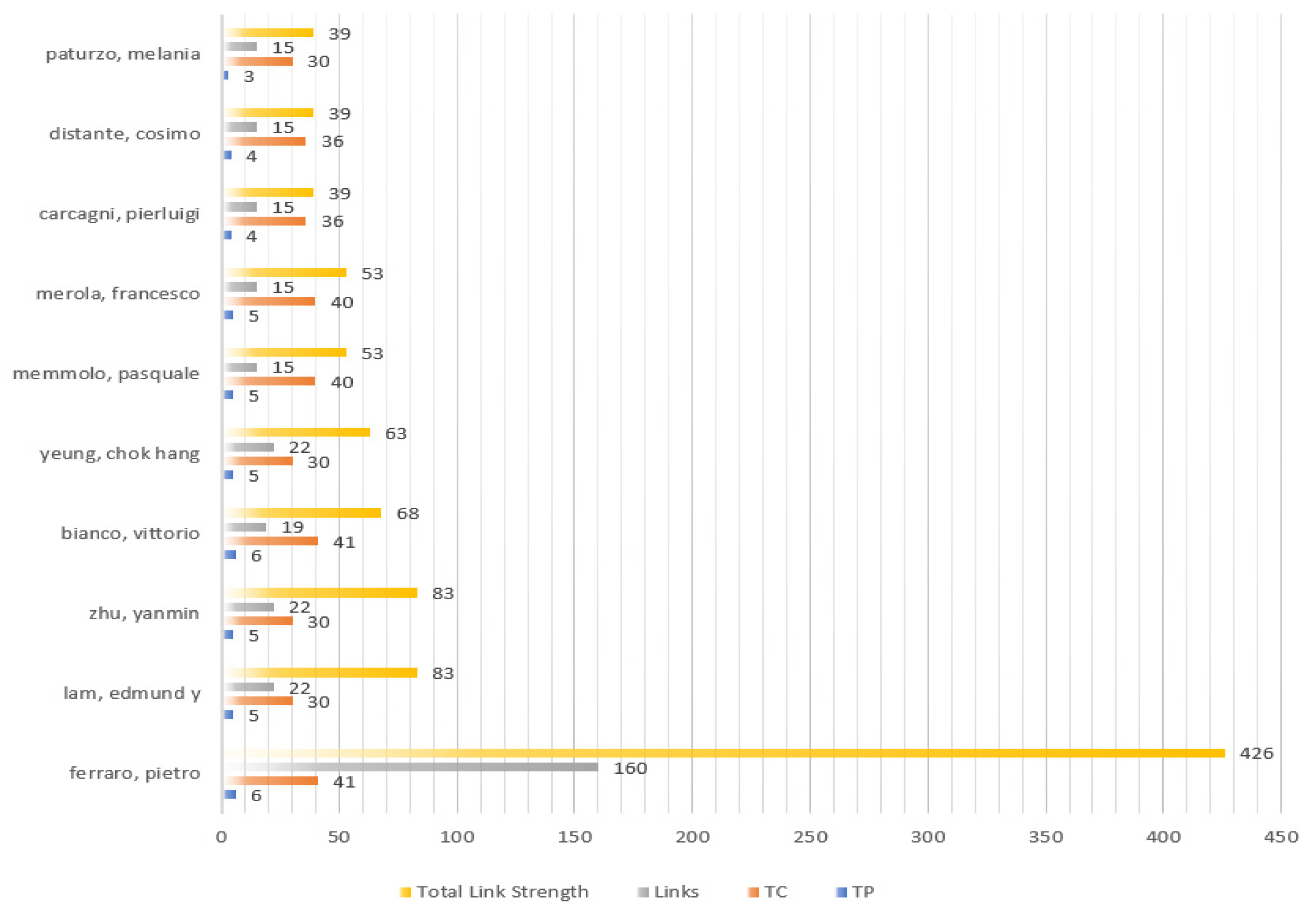
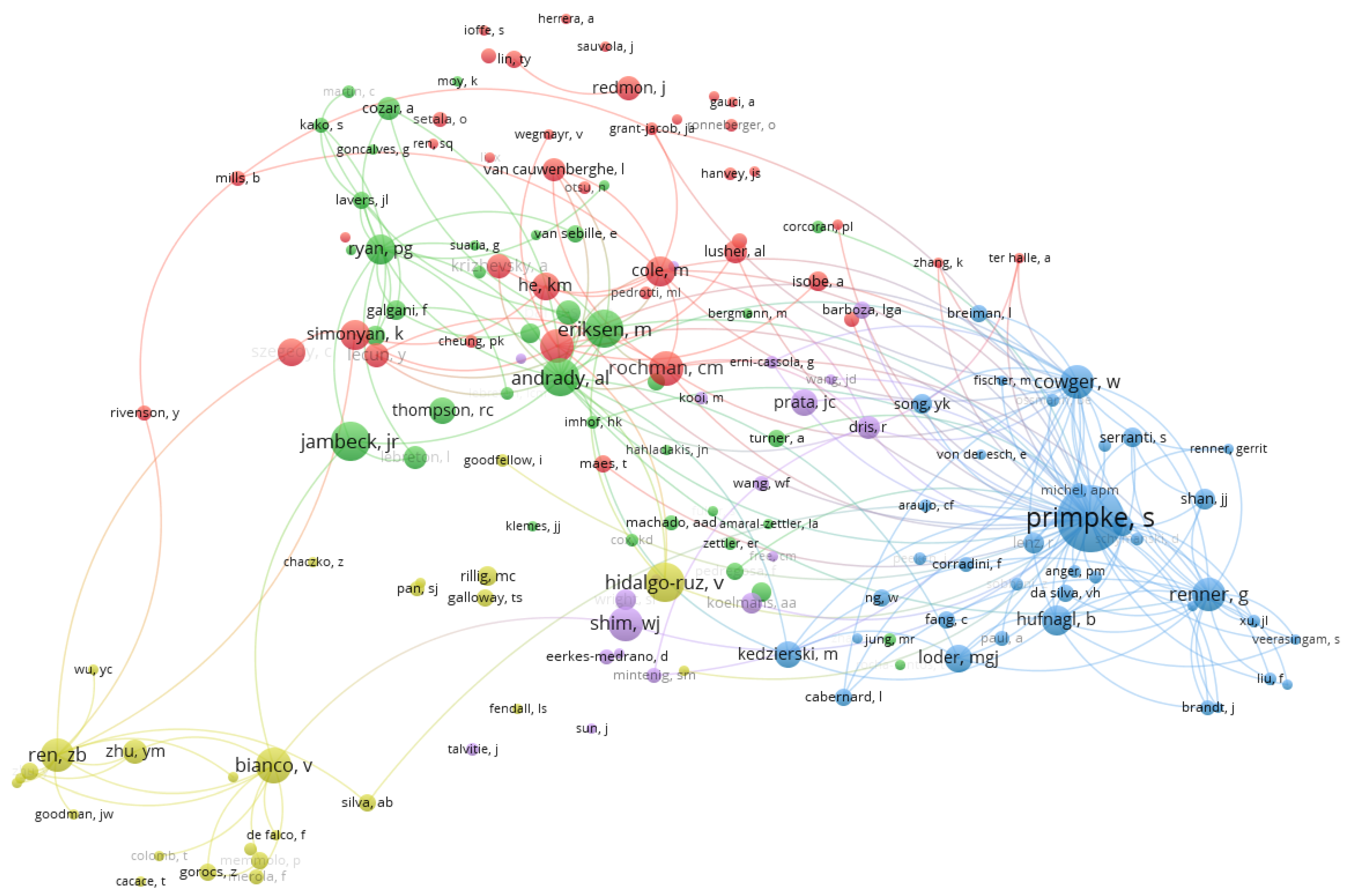
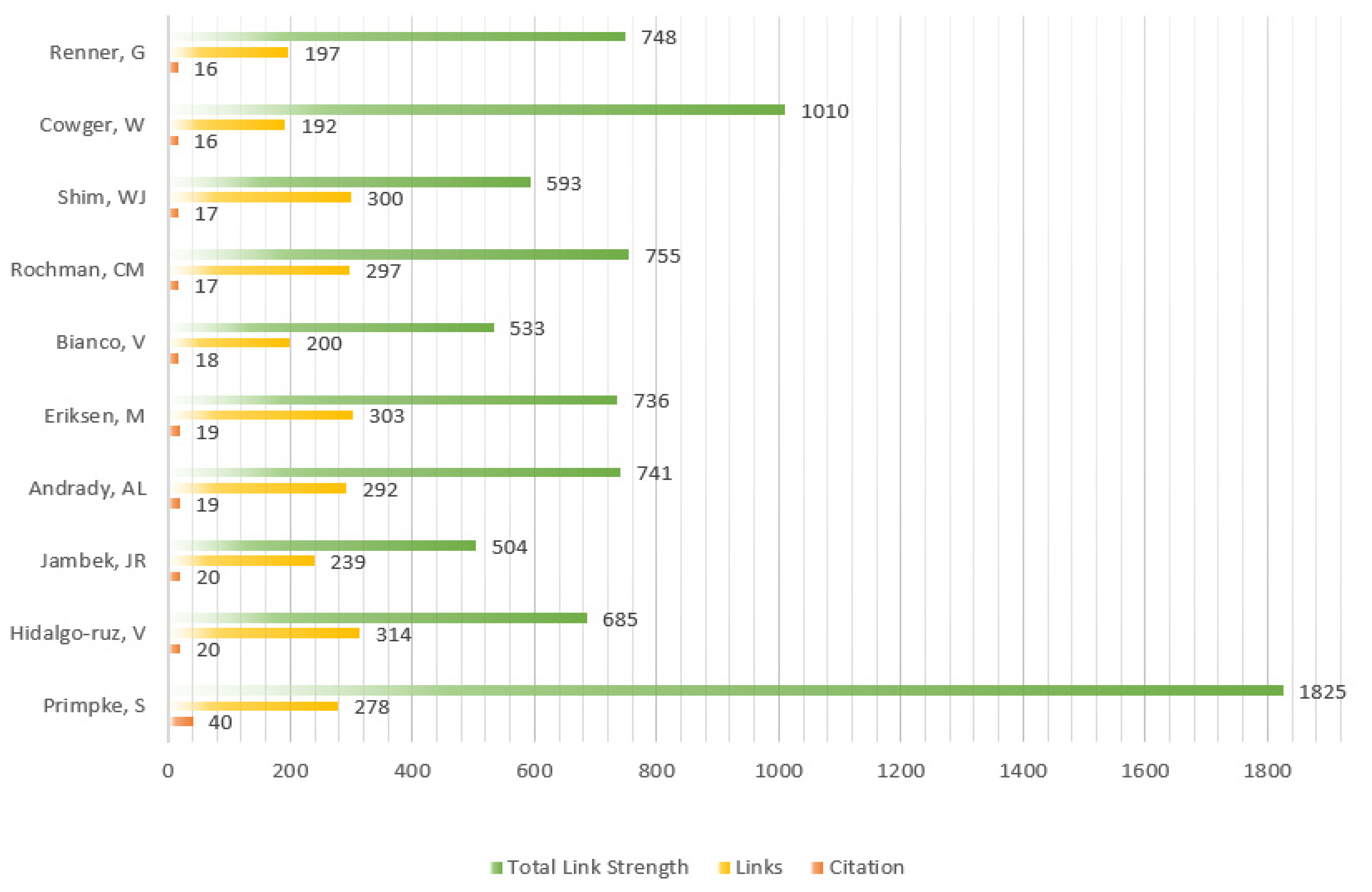

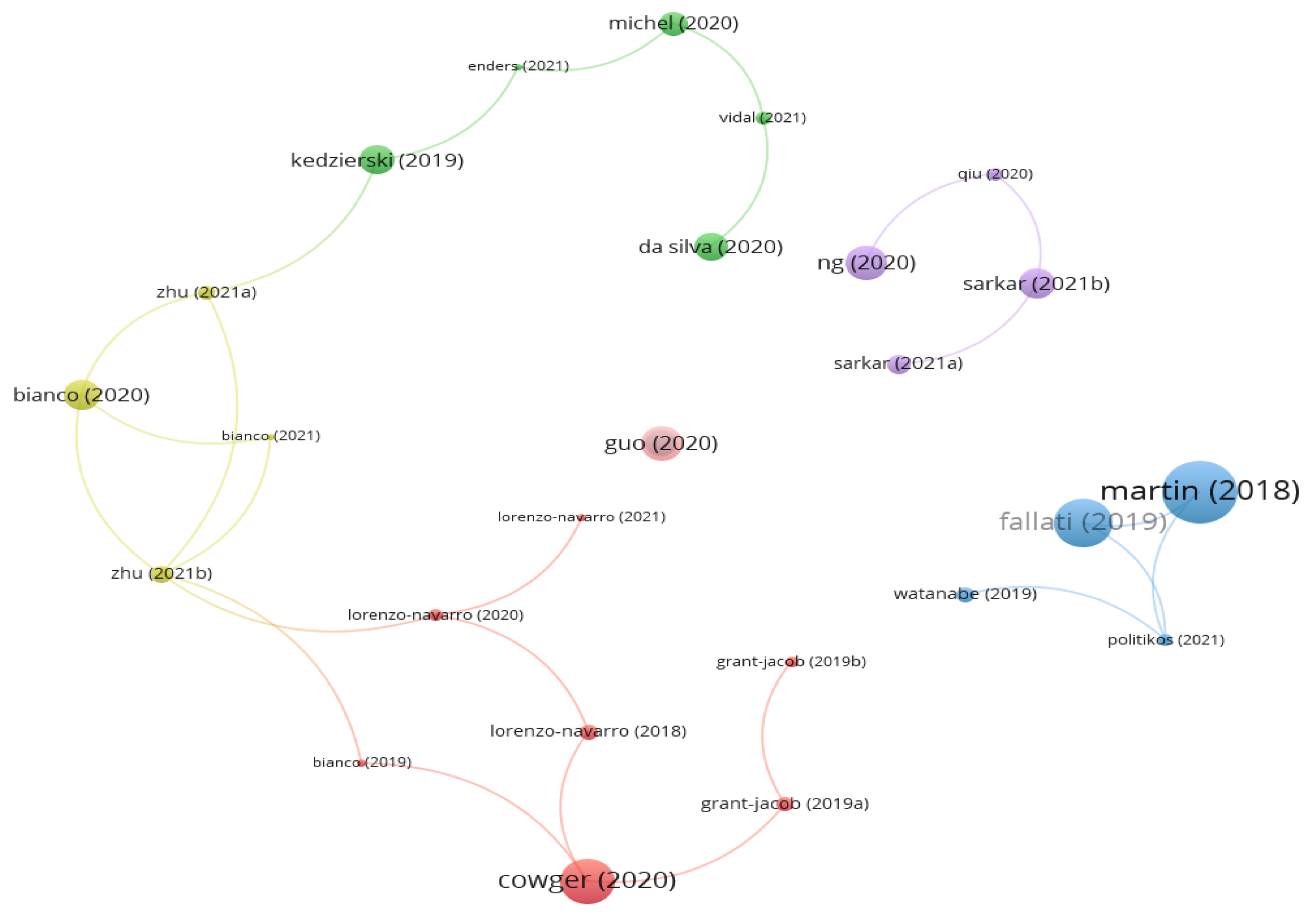

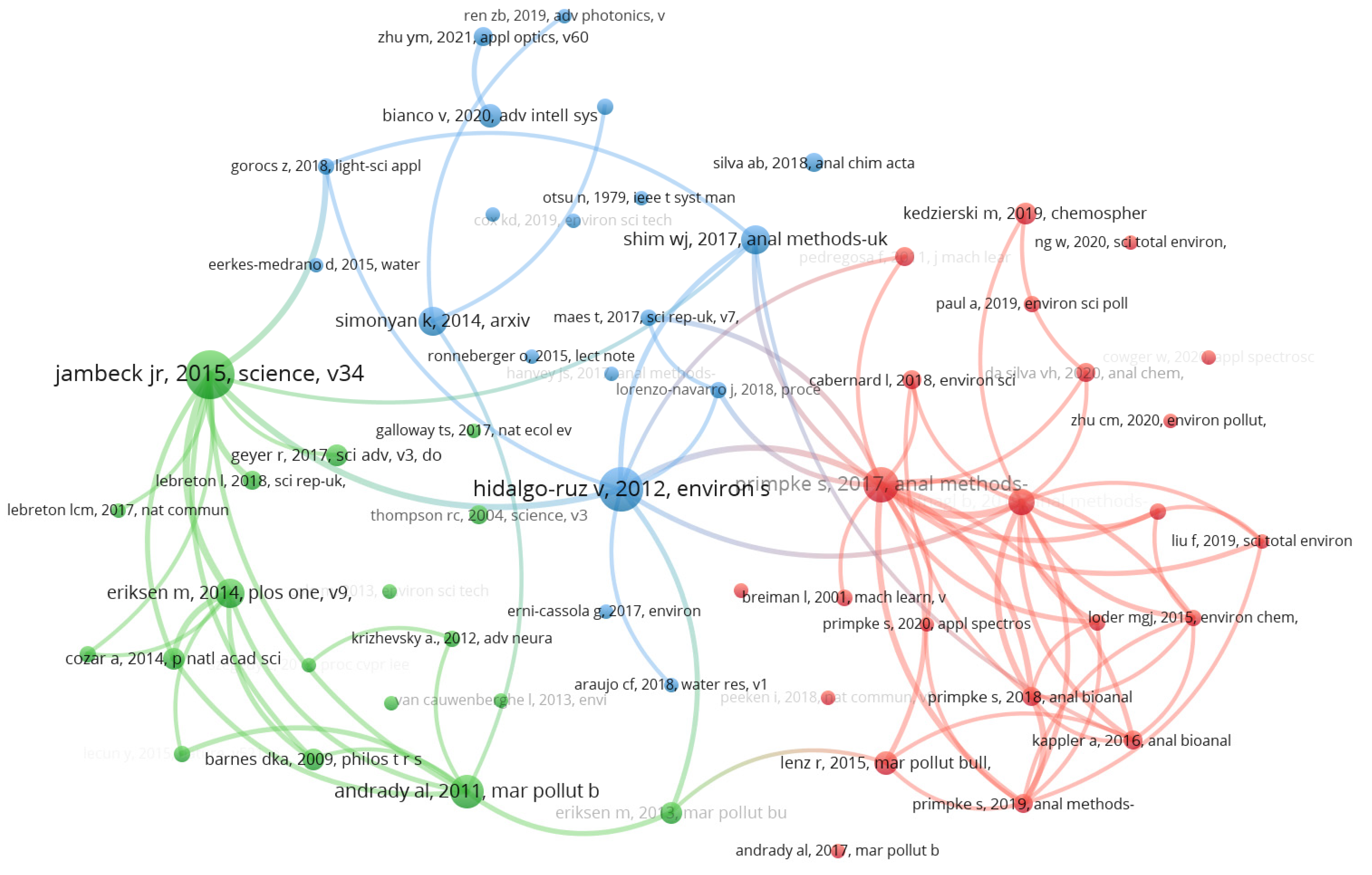
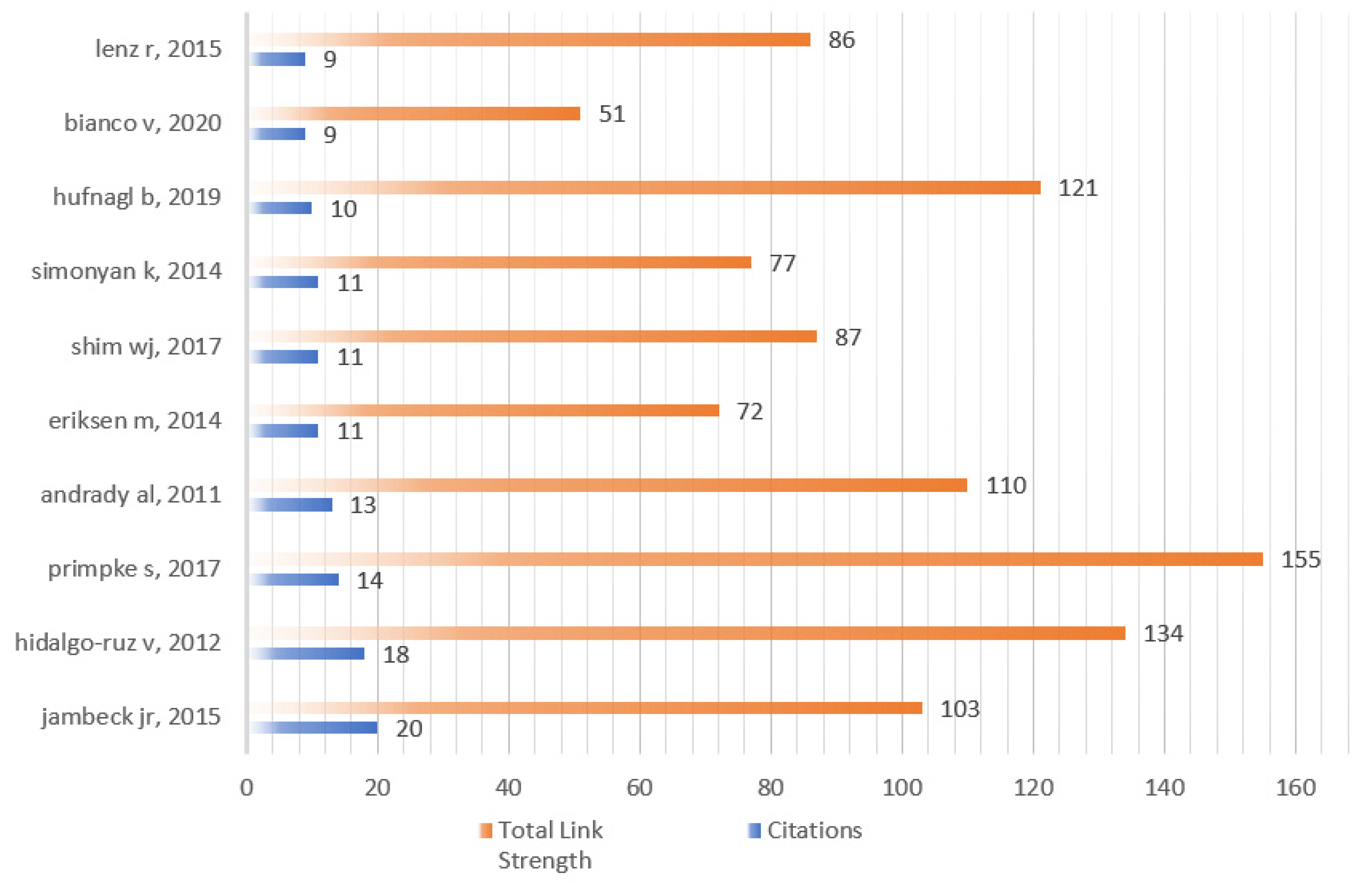

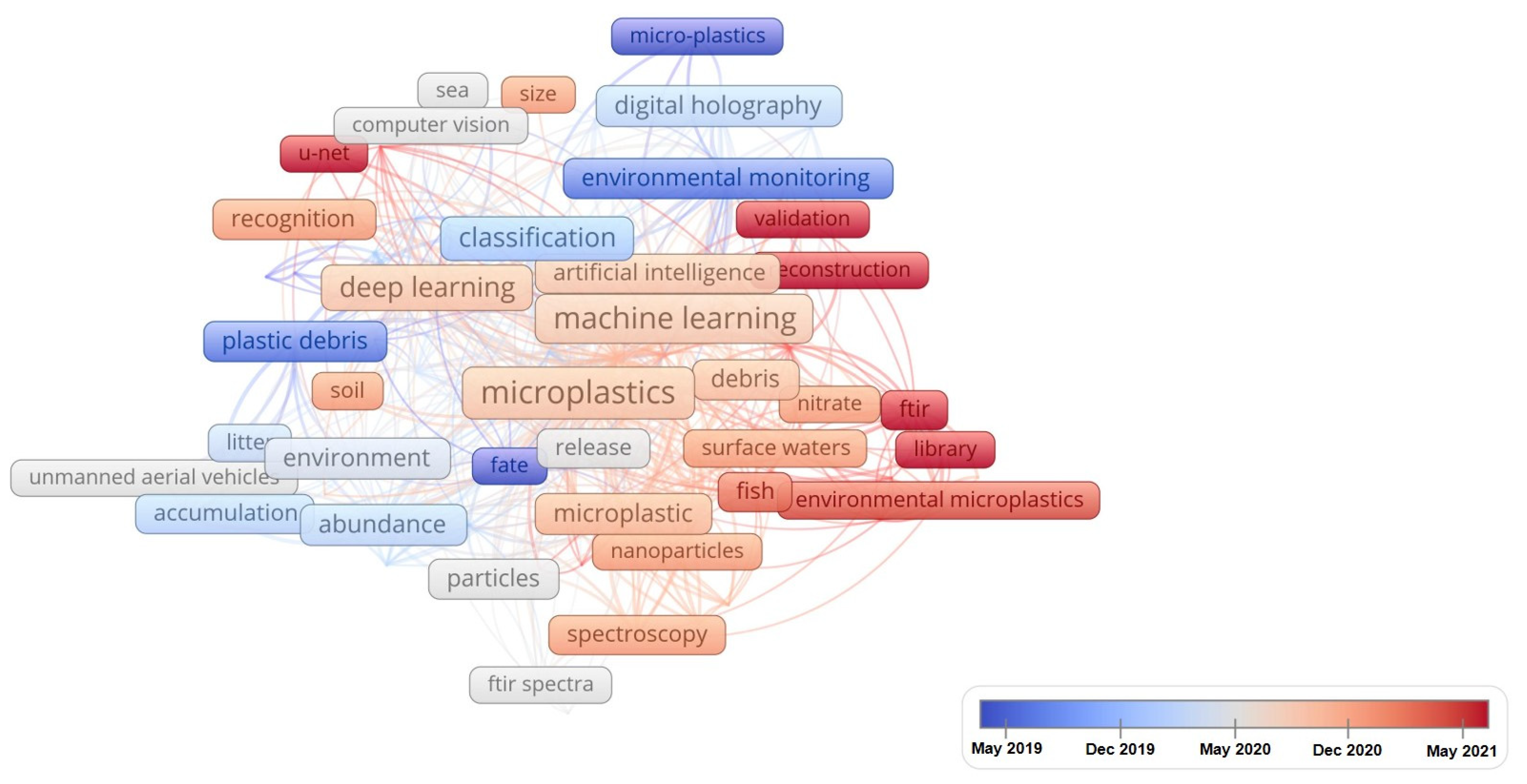
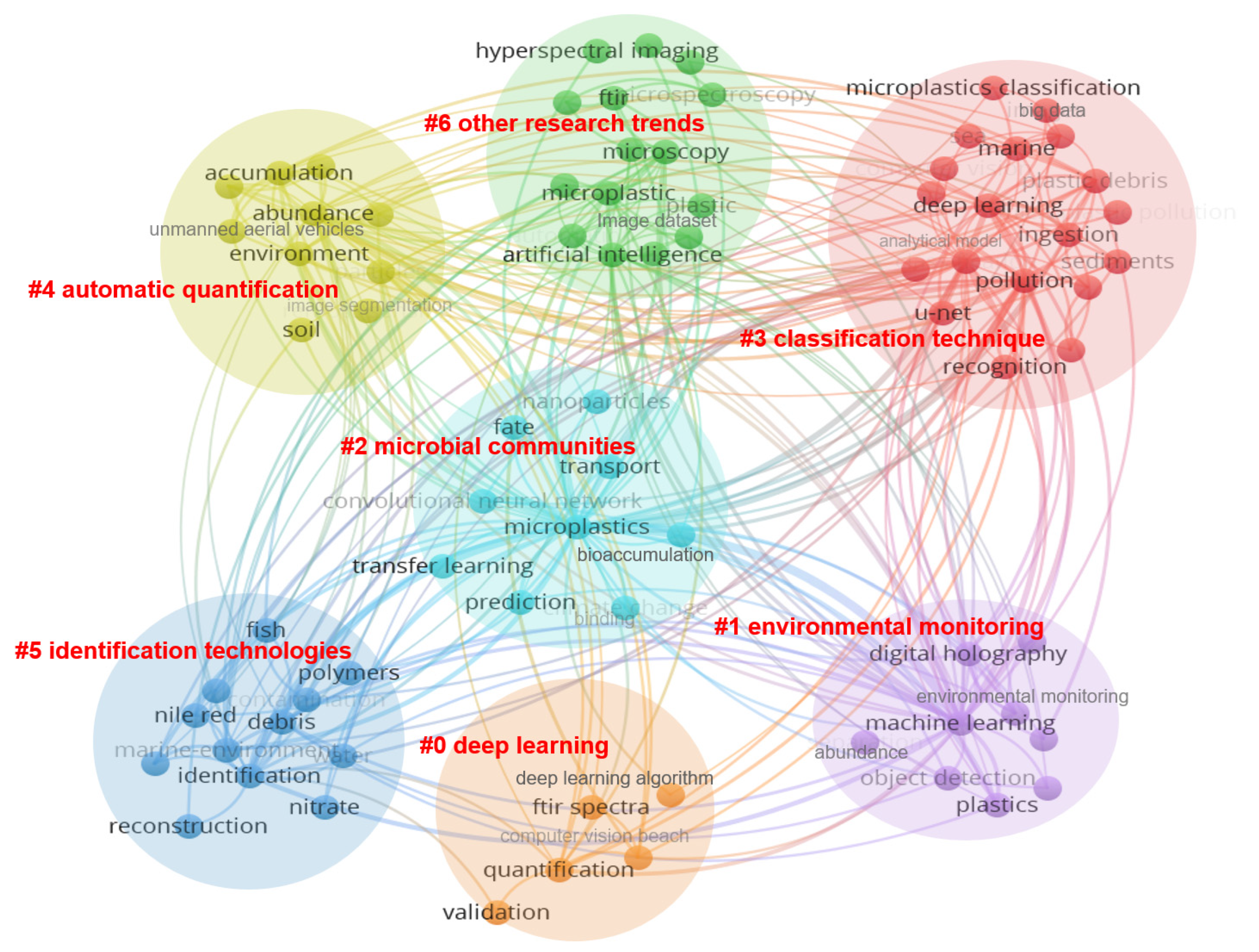
| Prefix | Synonyms | Approaches | Processing |
|---|---|---|---|
| Micro- | Microplasti * | Artificial intelligence | automa * |
| Micro-plastic * | convolutional neural network * | calculat * | |
| Nano- | Nanoplastics | deep learning | count * |
| Nanometer-plasti * | machine learning | classif * | |
| MPs | neutral network * | detect * | |
| digit * | |||
| identif * | |||
| imag * | |||
| quanti * | |||
| recogni * | |||
| sort * | |||
| statist * | |||
| visualiz* |
| Geographical Distribution | Country Name |
|---|---|
| Mainland China | China |
| Taiwan | China |
| Macao | China |
| Hongkong | China |
| North Ireland | UK |
| Scotland | UK |
| Wales | UK |
| England | UK |
| Database | Range |
|---|---|
| Science Citation Index Expanded (SCI-EXPANDED) | 1900—as of now |
| Social Sciences Citation Index (SSCI) | 1900—as of now |
| Conference Proceedings Citation Index-Science (CPCI-S) | 1900—as of now |
| Conference Proceedings Citation Index-Social Science & Humanities (CPCI-SSH) | 1900—as of now |
| Emerging Sources Citation Index (ESCI) | 2017—as of now |
Disclaimer/Publisher’s Note: The statements, opinions and data contained in all publications are solely those of the individual author(s) and contributor(s) and not of MDPI and/or the editor(s). MDPI and/or the editor(s) disclaim responsibility for any injury to people or property resulting from any ideas, methods, instructions or products referred to in the content. |
© 2023 by the authors. Licensee MDPI, Basel, Switzerland. This article is an open access article distributed under the terms and conditions of the Creative Commons Attribution (CC BY) license (https://creativecommons.org/licenses/by/4.0/).
Share and Cite
Zhang, Y.; Zhang, D.; Zhang, Z. A Critical Review on Artificial Intelligence—Based Microplastics Imaging Technology: Recent Advances, Hot-Spots and Challenges. Int. J. Environ. Res. Public Health 2023, 20, 1150. https://doi.org/10.3390/ijerph20021150
Zhang Y, Zhang D, Zhang Z. A Critical Review on Artificial Intelligence—Based Microplastics Imaging Technology: Recent Advances, Hot-Spots and Challenges. International Journal of Environmental Research and Public Health. 2023; 20(2):1150. https://doi.org/10.3390/ijerph20021150
Chicago/Turabian StyleZhang, Yan, Dan Zhang, and Zhenchang Zhang. 2023. "A Critical Review on Artificial Intelligence—Based Microplastics Imaging Technology: Recent Advances, Hot-Spots and Challenges" International Journal of Environmental Research and Public Health 20, no. 2: 1150. https://doi.org/10.3390/ijerph20021150
APA StyleZhang, Y., Zhang, D., & Zhang, Z. (2023). A Critical Review on Artificial Intelligence—Based Microplastics Imaging Technology: Recent Advances, Hot-Spots and Challenges. International Journal of Environmental Research and Public Health, 20(2), 1150. https://doi.org/10.3390/ijerph20021150









